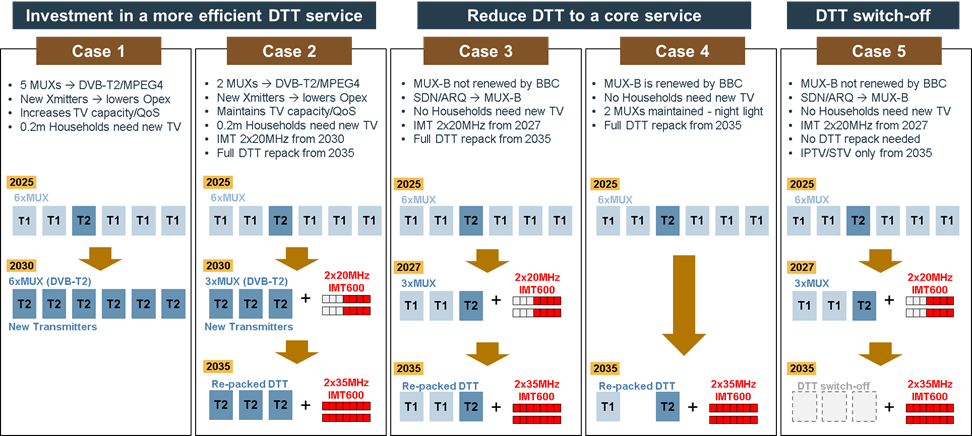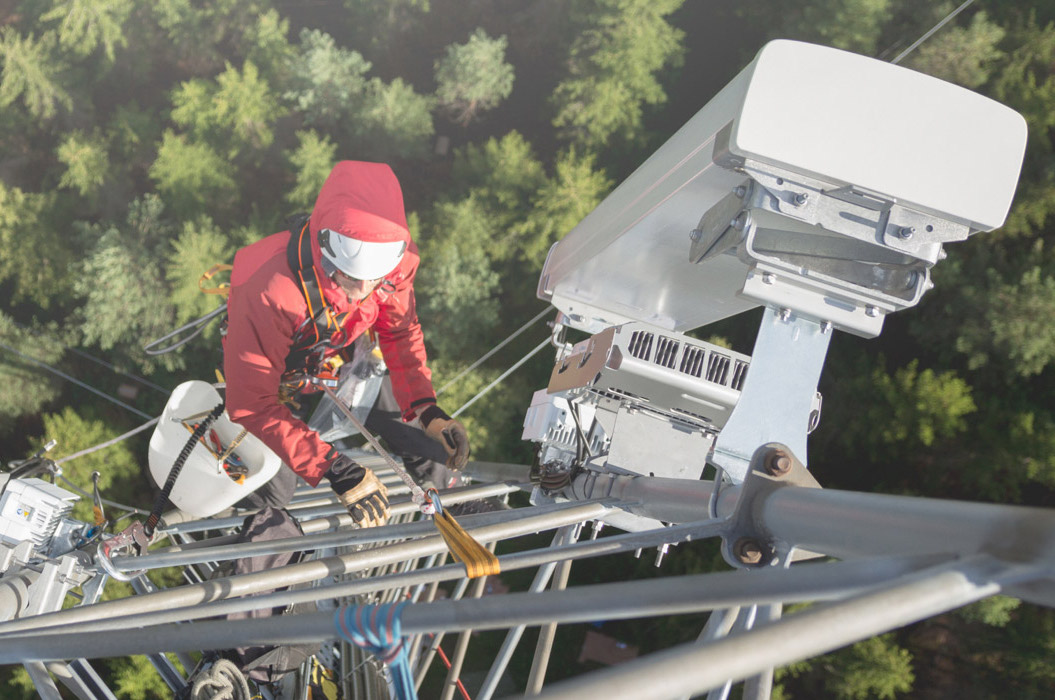Implications of a Full Transition from DTT to IPTV in the UK by 2035
In May this year, Coleago published a report prepared for the UK Spectrum Policy Forum which provides a technical and strategic assessment of future options for use of the UHF band (470–694 MHz) in the United Kingdom beyond 2034.

The report examined five potential evolution cases for Digital Terrestrial Television (DTT), ranging from continued investment in a more efficient DTT network to a complete switch-off and reallocation of spectrum for mobile broadband in the 600 MHz band (often termed IMT600). It evaluated these scenarios primarily through the lens of spectrum efficiency, network costs, coexistence with Programme Making and Special Events (PMSE) services, and implications for mobile network operators. While the analysis acknowledges the potential transition to Internet Protocol Television (IPTV) as a long-term scenario (Case 5 in the chart below), we did not undertake a detailed examination of the technical, operational, or socio-economic challenges associated with such a transition. Instead, the focus was on spectrum planning, reconfiguration costs, and the technical feasibility of various DTT evolution pathways.
Overview of DTT evolution cases assessed

The potential withdrawal of Digital Terrestrial Television (DTT) services in the UK by 2035, with a full transition to IPTV-based distribution, would represent a major policy shift with complex technical, socio-economic, and regulatory implications. While the primary objective may be to release valuable UHF spectrum (470–694 MHz) for alternative uses such as mobile broadband (IMT600), the broader consequences of this transition must be carefully considered. This article outlines the principal issues likely to arise from such a scenario, with specific reference to television accessibility, broadband capacity, spectrum efficiency, and the potential impacts on broadcast radio.
Digital Inclusion and Social Equity
Although the penetration of IPTV and broadband-enabled services continues to increase, a material proportion of the UK population—particularly older adults, those on low incomes, and people with disabilities—still rely on DTT for access to free-to-air television. As of 2023, 11.6% of UK households (approximately 3.3 million) were classified as DTT-only, and an estimated 7% of households lacked a fixed broadband connection.1
The transition to IPTV must be accompanied by robust policy measures to avoid exacerbating digital exclusion. These may include subsidised broadband access, support for digital literacy, and targeted assistance for equipment upgrades.
Network Capacity and Service Reliability
Replacing DTT with IPTV would place substantial new demands on both fixed and mobile broadband infrastructure. Peak-time live television events currently delivered via spectrum-efficient broadcast channels would, in an IPTV model, require high-capacity unicast or adaptive multicast delivery. This may lead to congestion, service degradation, or uneven quality of experience—particularly in rural areas or in premises where fixed broadband access is limited or unaffordable. Ensuring adequate network resilience and managing energy consumption across a more distributed delivery model are therefore critical considerations.
Spectrum Reallocation and Coexistence
The anticipated reallocation of UHF spectrum, particularly through the implementation of an IMT600 band plan, could significantly benefit mobile operators by enabling enhanced rural coverage and indoor penetration. However, this reallocation must also consider the needs of Programme Making and Special Events (PMSE) users, who depend on UHF frequencies for wireless microphones, in-ear monitors, and other essential audio equipment. Without mitigation strategies—such as carefully managed spectrum sharing, the allocation of alternative bands or the adoption of technologies like Wireless Multichannel Audio System (WMAS) which promise more spectral efficiencies—these users could face serious operational constraints.
Implications for FM Radio Broadcasting and Smart Metering
While FM radio primarily operates in the 87.5–108 MHz band and is therefore not directly impacted by changes to the UHF band, the broader context of shifting media consumption habits and digital convergence is relevant. The potential obsolescence of legacy DTT infrastructure may prompt parallel reviews of analogue FM services, particularly considering recent efforts on Digital Audio Broadcast (DAB) rollout policies. If UHF DTT infrastructure is decommissioned entirely, there may be implications on shared running costs at sites currently used to support both TV and FM radio broadcasts.
Moreover, any reduction in free-to-air platforms could inadvertently affect the perceived value of maintaining FM services for public service broadcasting, emergency communications or accessibility for digitally excluded populations. Policymakers may therefore wish to assess FM radio policy concurrently to ensure continued media universality.
Although smart metering in the North of England and Scotland operates using Arqiva’s 2×2 MHz allocation within the 412–424 MHz band and will not be directly affected by changes to the UHF spectrum, the service’s viability may nonetheless be influenced due to its reliance on Arqiva’s DTT broadcast tower network.
Legal, Regulatory and Commercial Considerations
Finally, a move to IPTV must be accompanied by a coordinated legal and regulatory framework. Issues such as prominence for Public Service Broadcasters on IPTV platforms, obligations for universal service coverage, and cross-border interference protection and coordination—especially with Ireland and France—will all require resolution. Furthermore, commercial broadcasters must assess the viability of continued investment in DTT versus online distribution models. A decision by the BBC regarding its MUX-B licence, which is due for renewal in 2026, may serve as a key inflection point.
If there were to be a DTT switch-off and IMT600 was allocated in the frequency range 614 to 698 MHz, there is an important issue regarding what the remaining spectrum below 614 MHz would be used for. Another subject for the policy makers and Ofcom to consider.
Conclusion
The proposed cessation of DTT broadcasting in favour of IPTV by 2035 would have far-reaching implications that extend well beyond television distribution. While the spectrum efficiency and economic potential of reallocation are considerable, so too are the risks of social exclusion, infrastructure strain, and disruption to other services such as FM radio broadcasting and smart metering networks.
A successful transition will require a phased, inclusive, and carefully governed approach. Policymakers, regulators, industry stakeholders, and civil society must work together to ensure that the future media and communications landscape is robust, equitable, and aligned with long-term national objectives.
1 Ofcom, Future of TV Distribution, 2024
Other insights

Tanzania’s 3.6 GHz Spectrum Auction: Key Insights and Lessons for Future 5G Awards
Tanzania’s recent 3.6 GHz spectrum auction marks a major step toward 5G, but its design choices raise important questions about efficiency and fairness. Coleago’s latest white paper reviews the TCRA auction and shares key lessons for regulators and operators shaping future 5G spectrum awards.

The European 5G Fairytale
For years, European policymakers and telecom operators have touted the impressive figure: “89% 5G coverage of populated areas.” On paper, this paints a picture of near-ubiquitous, high-speed connectivity. Scratch the surface however, and the reality looks quite different.

Maximising Shareholder Value in Spectrum Auctions
Spectrum auctions, while common in the telecom industry, are complex and high-risk events that can significantly influence a company’s long-term performance. Missteps, especially vague auction objectives and poor valuation discipline, can lead to substantial destruction of shareholder value.

Spectrum and Regulatory Challenges Related to eVTOLS
Electric Vertical Take-Off and Landing (eVTOL) aircraft are poised to revolutionise urban mobility, with commercial operations expected to begin as early as 2025 and significant growth anticipated by the 2030s.

Future of the UHF Band after 2024: An Analysis of Options in the UK
Coleago Consulting in collaboration with its client, the UK Spectrum Policy Forum, has released a landmark report, “Future of the UHF Band After 2034,” setting out a detailed assessment of the United Kingdom’s Ultra High Frequency (UHF) spectrum landscape. The report looks at the industry trends and the critical trade-offs required to balance the needs of Digital Terrestrial Television (DTT), Mobile Communications, and Programme Making and Special Events (PMSE).

The Polish 700 and 800 MHz Spectrum Auction: Insights and Global Lessons
Poland’s final low-band spectrum auction marks a pivotal moment in Europe’s 5G rollout, offering key lessons in auction design, cross-border coordination, and strategic spectrum management.